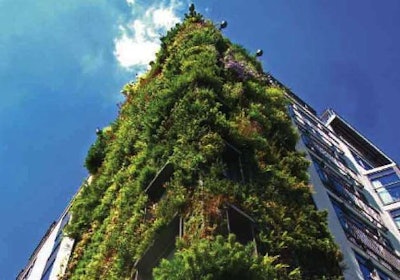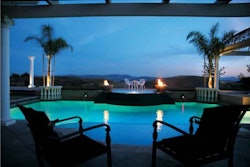 Athenaeum Hotel, London
Athenaeum Hotel, LondonBy Jenny Agee-Aldrich
What goes up, must go around. Vertical gardens serve many purposes and showcase various looks depending on the designer and location: Lush foliage couture to dress up the exterior of Parisian buildings. Living green billboards in America to promote a corporation’s environmental mission. Mitigation for urban sprawl in Japan.
“People really notice vertical planes. Colors and textures on vertical surfaces tend to have a strong influence on the perception of a space,” says Bruce Dvorak, a landscape architecture professor at Texas A&M University. “Vertical gardens provide a contrast to stone, concrete glass and other building materials.”
While you may not be ready to add large scale vertical gardens to your design/build portfolio, read on to learn how they may inspire you to view spaces in a more open way and to look beyond just the ground beneath your feet.
We interviewed some of the world’s most noted vertical garden designers to learn about their inspiration, methods and the nuts and bolts involved in their work.
French first
French botanist Patrick Blanc is credited for conceiving the idea for modern-day vertical gardens, also known as green walls. He has designed vertical gardens across the world, but his most famous projects are in Europe where buildings such as the Athenaeum Hotel in London’s Mayfair district have been transformed into living works of art. It contains 260 species of plants and stands eight stories high.
This vertical garden, which graces Taiwan’s National Concert Hall, took Blanc three weeks to design and build.Blanc first became interested in vertical gardens at the age of 19 when he noticed plants naturally growing up tree trunks and rocks in the forests of Thailand. “When I got home, I wanted to do the same thing,” he said in a 2008 interview at the Chelsea Flower Show in London.
Maintenance of the walls is simple, Blanc says, because he merely starts the process and lets nature take over. When designing the walls, Blanc carefully chooses the location where each species of plant will thrive. The bottom of his walls contains plants that flourish with shade and moisture. The top works best for sun-loving plants.
Blanc is in high demand and can be challenging to book for a project. But Charlotte, North Carolina, boutique owner Laura Vinroot Poole got lucky. She and her husband befriended Blanc at a party in India where he agreed to design a garden that now graces the patio of Poole’s chic boutique, Capitol. She already was familiar with his work, having admired his green facades in Paris when she went on buying trips for her clothing store.
And it just so happened that Blanc was familiar with the plants of the Southeast and subsequently contacted a nursery, Plants Delight, near Charlotte to grow plants for the project. He sent them a blue print of the design six months before installation. When the plants were ready, Blanc’s team assembled the two-story high wall in a week, and a local plumber installed the drip irrigation.
“It’s constantly changing. I see something new every day – new flowers, new colors,” Poole says. “I’m proud to bring this magnificent work to the South to show off our indigenous plants.”
Sprawl antidote in Japan
Vertical gardens are more about practicality than aesthetics in Japan. “Unfortunately, most of the vertical gardens here are far from works of art,” says Kazuyuki Ishihara, owner of Ishihara Kazuyuki Design Laboratory in Tokyo and a three-time gold medalist at London’s renowned Chelsea Flower Show.
Although he is respected for his expressive landscape designs around the world, Ishihara’s artful approach isn’t the norm in Japan where most vertical gardens are simply vines planted to climb the exterior of buildings. In contrast, Ishihara has installed more than 100 vertical walls in Japan, painstakingly creating his designs and choosing each plant carefully. His work can also be seen in England and Singapore.
Ishihara’s “Garden of Clouds” was a Gold Medal Winner at the 2007 Chelsea Garden Show.Practically speaking, plantings that cover exterior building walls reduce interior space temperatures. And in some cases, adding green space to new construction in cities such as Tokyo is required by municipal ordinances to reduce greenhouse gas emission.
“There is no doubt that vertical gardens have become mainstream for urban greenery,” Ishihara says. “Green space is limited in big cities like Tokyo. All new buildings with floor space more than 300 square meters are required to include green space.”
He uses indigenous plants, such as holly fern, camellias and photimia, in his designs because they are more sustainable.
Ishihara built his first green wall 10 years ago in an urban area with limited space. “At that time, I felt it would be more beautiful to build the garden vertically, rather than building a tiny garden on the ground,” he says.
Growing up in Nagasaki, Ishihara says he developed a strong passion for world peace, which he first channeled through flower arrangement, and now, as a landscape designer. “Living an urban lifestyle can lead one to lose touch with his environment,” he says. “Plants and gardens are a way to help reconnect people to nature.”
Greening Canada’s grey
Rooftop Chimney Garden by Green Over Grey, Vancouver.Mike Weinmaster, co-owner of Green Over Grey in Vancouver, Canada, traveled the world for four years studying green walls in nature before opening his business in 2008, which specializes in the design and installation of vertical walls.
“They add biodiversity and a sense of calm,” Weinmaster says. “Green walls are popular because humans have an ingrained connection to nature.”
By the year 2050, much of the world’s population will live in urban areas, Weinmaster says. “Such a major shift away from rural and naturally vegetated areas to sterile concrete environments is not healthy.” Installing interior and exterior green walls presents a natural remedy to the challenges presented by massing more people in smaller spaces.
The patented system installed by Green Over Grey creates a soil-free scheme in which certain plants, such as epiphytes and hemiepiphytes, thrive. Weinmaster also uses a variety of woody and herbaceous perennials, cascading groundcovers, bushes, shrubs and even some trees in his installations. However, he stays away from vines, since they tend to become invasive.
The Semiahmoo Sky Garden, which adorns the public library in Surrey, Canada, is one of the largest outdoor green walls in North America.Semiahmoo Sky Garden, which canvasses the exterior of a public library in Surrey, Canada, is Weinmaster’s favorite project and includes more than 10,000 plants representing more than 120 species. The larger plants will grow 6 to 7 feet out from the wall. “Having such a large canvas allowed me to let my creativity run wild,” he says. “It also gives enough space for patterns to take shape and lets each species showcase its unique beauty.
“Our creations have been called living paintings, with the plants being our brush strokes and the walls our canvases,” he says.
But like traditional plantings in horizontal schemes, vertical gardens require upkeep and ongoing care, according to Weinmaster. His team offers maintenance packages with installations, which include pruning the plants, integrated pest management, replenishing of the hydroponic nutrient solutions and plant replacement when needed.
American know wow
From marketing corporations in unique ways to growing large amounts of vegetables and fruits in small spaces, the vertical walls designed by George Irwin produce big results.
The lower area of this Philadelphia garden includes herbs the owner of the rowhouse uses for cooking.Irwin is founder of Green Living Technologies International of Rochester, New York. The company has been manufacturing, designing and installing green roofs and walls since 1999.
Irwin has designed many prominent green walls at home and abroad, including one that blankets the side of the PNC Financial Corporation’s headquarters in Pittsburgh, Pennsylvania. The project was completed in time to catch the eyes of world leaders on their way to the nearby G-20 Summit held in Pittsburgh in 2009. “Since this was the bank’s headquarters, it made quite a statement,” Irwin says of the PNC project. “It was marketing genius.
“There are a variety of reasons a client will request a green wall,” he says. “One of the primary ones is the ‘wow’ factor and the return on the investment from the eco-marketing capabilities of our walls.”
Although he has installed some of the world’s largest commercial green walls, Irwin says he is most inspired by the edible walls he designs. He started building them as a lark when his children wanted to grow lettuce on the family’s green wall in their home. Soon, they successfully added other fruits and vegetables, such as tomatoes. The company’s first commercial edible wall was built in Los Angeles, California, to help feed the homeless.
“The aesthetics of the walls selfishly please my love for the art,” Irwin says. “However, it’s the power we possess to grow food and change the agricultural and economic landscapes that really interests me.”
Recipe for a vertical garden
Vertical gardens can be grown with or without soil, indoors or out. First, the wall is waterproofed and a plastic or metal frame is secured to it to support the plants. For gardens that don’t use soil, fabric sandwiches hold the plants in place and manage moisture. Other systems use trays or pockets packed with soil. Most are drip irrigated.











